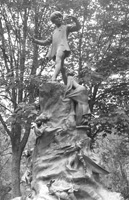
The Peter Pan statue
Edgar Bowring was born in St. John’s on Aug. 17, 1858, the son of John Bowring and Mary Rennie. His father was the youngest son of Benjamin Bowring, who established the Bowring business in St. John’s in 1811. His mother was a daughter of the Rennie family who established the famous Rennie’s Mill on the river that still bears the family name.
Edgar began his education at Bishop Feild College, but at age 11, in 1869, he was sent to England to attend schools at Liverpool and Scarborough. He returned to St. John’s in 1875 and joined the family business, by then known as Bowring Brothers. In 1886 he was made a full partner in the business.
With the unexpected death of his cousin, Charles, in 1890, Edgar became managing director and senior resident partner of the company in Newfoundland. He would eventually become a director of Bowring subsidiaries in Liverpool and New York. In 1936 he became chairman of the board of Bowring’s parent company in London.
He turned some of his responsibilities in Newfoundland over to his cousin Eric Bowring in 1909, but continued to be involved in the company’s management until his death. Under his guidance, the business expanded and prospered.
Bowring Brothers owned a large fleet of ships. One of the vessels Bowring acquired was the Florizel, in 1909.
A steel-hulled passenger vessel, which doubled as a sealing ship during the spring hunt, the Florizel became a troop ship on Oct. 4, 1914, when it left for England with the first 500 members of the Newfoundland Regiment.
On Feb. 23, 1918, the Florizel foundered on the rocks off Cappahayden, on its way to Halifax and New York; 94 passengers and crew perished in the wreck, while only 44 were rescued. The ship was a complete loss.
As a politician, Bowring never ran for elected office, but in 1897 he was appointed to the Legislative Council, Newfoundland’s upper house, where he served for almost 30 years.
He was appointed Newfoundland’s representative on Great Britain’s Dominions Royal Commission, established in 1912 to study the natural resources, trade and legislation of the major dominions of the Empire.
On Nov. 22, 1918 Bowring became Newfoundland’s first formal diplomat when he was appointed High Commissioner (ambassador) to Great Britain, a position he accepted without salary at his own request. He held that office until 1922, representing Newfoundland’s interests in London.
While there in 1921, he attended the first meeting of Newfoundland Club. He also served as High Commissioner during 1933-34.
It was as a philanthropist that Bowring is best remembered. In 1911, as part of the 100th anniversary of the Bowring enterprise, he presented the citizens of St. John’s with a gift of $50,000 which was used to purchase land to establish a park in the western part of the city, on the banks of the Waterford River.
Named Bowring Park in honor of the benefactor, it was designed by the Dutch landscape architect Rudolph Cochius, who spent five years (1912-1917) working on the project.

The Peter Pan statue
Bowring was also responsible for one of the major statues in park. On board the Florizel when it sank were Bowring’s stepson, John Shannon Munn, and his daughter, three-year-old Betty Munn, both of whom were drowned.
In her memory, Bowring commissioned the British sculptor Sir George Frampton to duplicate a copy of his statue of Peter Pan which stands in Kensington Gardens, London. The replica in Bowring Park, unveiled on Aug. 29, 1925, bears the dedication “In memory of a little girl who loved the Park.”
The other large statue in the park, The Caribou, was the gift of Bowring’s cousin, William Howe Green.
Other charitable works by Bowring include serving as finance chairman of the Newfoundland Patriotic Association and providing his St. John’s residence, Waterford Hall, as a convalescent home for wounded soldiers returning from Europe.
Edgar Bowring married Flora Clift Munn, a widow with children, in 1888. He became a father to her children, and her eldest, John Shannon Munn, became his protege, who was well secured in the management of Bowring’s St. John’s operations at the time of his death in the wreck of the Florizel.
Bowring was honored for his contributions to Newfoundland and the British Empire, with not one, but two knighthoods, being made a Knight Bachelor in 1915, and then raised to a Knight Commander of the Order of St. Michael and St. George in 1935.
Bowring Park remains a lasting legacy of his generosity to Newfoundland.
| front | local | mscl | music | news | sport |
| mail me | |||||